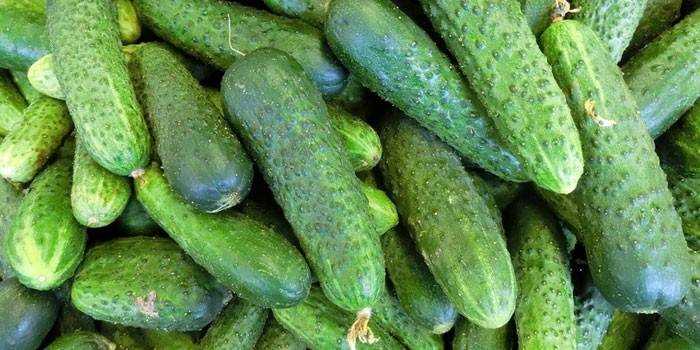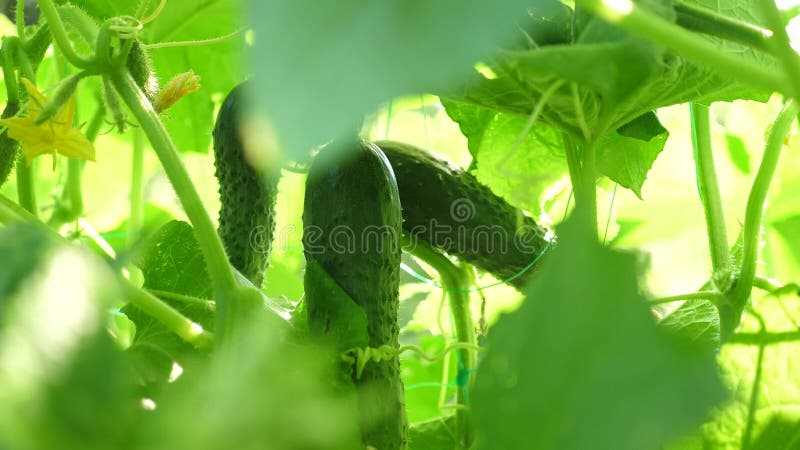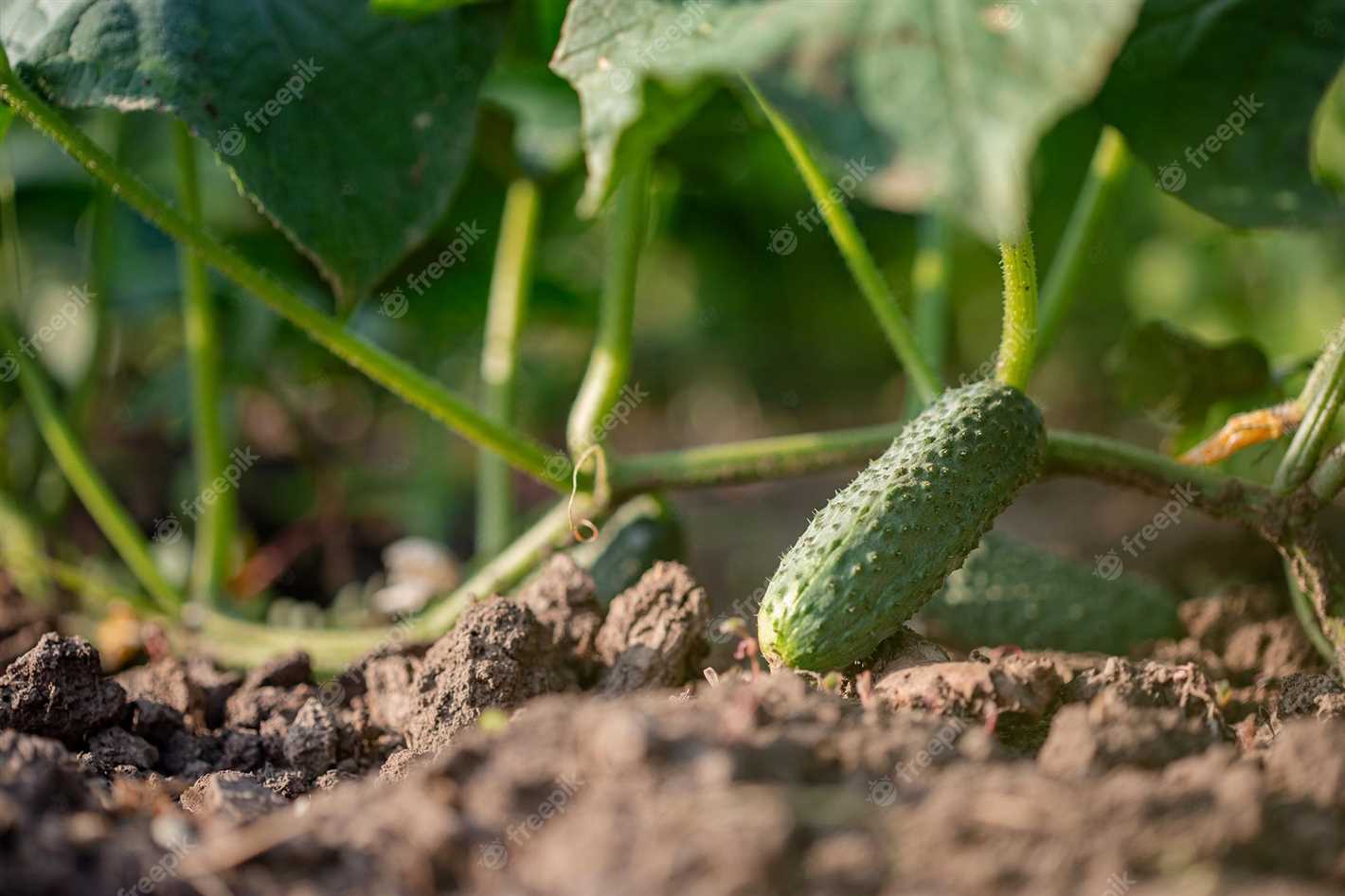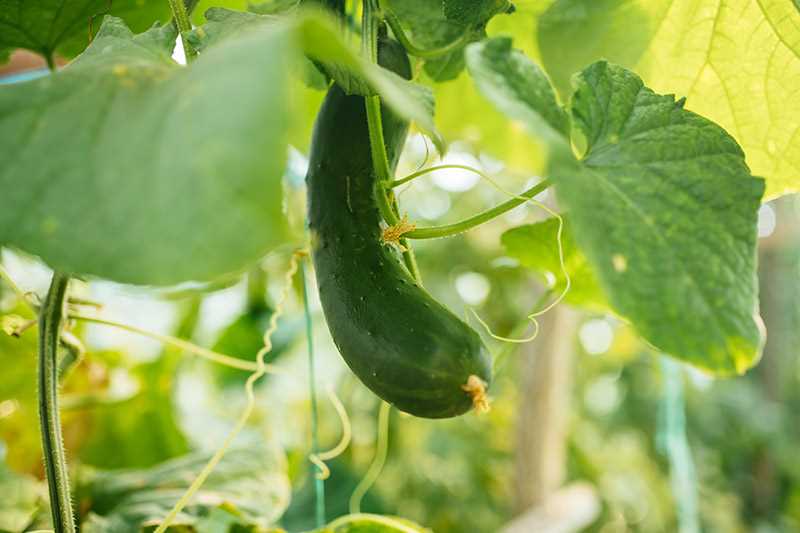- Cucumbers for Outdoor Cultivation
- Choosing the Right Varieties
- Planting and Care
- Harvesting
- Choosing the Right Cucumber Variety
- 1. Climate
- 2. Disease Resistance
- 3. Fruit Type
- 4. Yield
- 5. Size
- 6. Taste and Texture
- 7. Growing Space
- 8. Reviews and Recommendations
- Best Cucumber Varieties for Outdoor Growing
- 1. National Pickling Cucumber
- 2. Marketmore Cucumber
- 3. Lemon Cucumber
- 4. Straight Eight Cucumber
- 5. Armenian Cucumber
- 6. Bush Champion Cucumber
- Important Factors to Consider for Outdoor Cucumber Cultivation
- 1. Variety Selection
- 2. Soil Preparation
- 3. Sunlight
- 4. Watering
- 5. Trellising or Support
- 6. Pest and Disease Management
- 7. Harvesting
- Tips for Growing Cucumbers Outdoors
- Common Pests and Diseases in Outdoor Cucumber Cultivation
- Harvesting and Storing Outdoor Cucumbers
- 1. Timing
- 2. Check the Color
- 3. Firmness
- 4. Use Pruning Shears or a Knife
- 5. Harvest Regularly
- 6. Storage
- 7. Length of Storage
- 8. Avoid Storing with Certain Fruits and Vegetables
- 9. Freezing Cucumbers
- “Question-Answer”
- What are the top cucumber varieties for outdoor cultivation?
- Are there any disease-resistant cucumber varieties available for outdoor cultivation?
- How long does it take for cucumbers to mature?
- Can cucumbers be grown in containers?
- What are some tips for successful outdoor cultivation of cucumbers?
- Can cucumbers be grown in colder climates?
- What are the benefits of growing cucumbers outdoors?
- “Video” MiracleGro VS Pee: Which Fertilizer Is Better? Surprising Results!
Are you a passionate gardener looking to grow cucumbers outdoors? Look no further! In this ultimate guide, we’ll take you through the top cucumber varieties that are perfect for outdoor cultivation. From long and slender English cucumbers to crispy and flavorful pickling cucumbers, we’ve got you covered.
When it comes to growing cucumbers outdoors, choosing the right variety is crucial. You want a cucumber that can withstand the elements and still produce an abundance of delicious fruits. Whether you’re a beginner or an experienced gardener, our guide will help you make an informed decision and ensure a successful harvest.
We’ll cover everything from the characteristics and growing requirements of each variety to tips on caring for your cucumber plants. Don’t let limited space hold you back – we’ll also discuss compact cucumber varieties that are perfect for small gardens or container cultivation.
So grab your gardening tools and get ready to dive into the world of outdoor cucumber cultivation. With our ultimate guide, you’ll soon be enjoying freshly picked cucumbers straight from your own garden. Let’s get started!
Cucumbers for Outdoor Cultivation

Growing cucumbers in an outdoor garden can be a rewarding experience. The fresh flavor and crunchiness of homegrown cucumbers are unmatched, and they are a versatile and refreshing addition to salads, sandwiches, and pickles.
Choosing the Right Varieties
When selecting cucumber varieties for outdoor cultivation, it is important to consider factors such as disease resistance, yield, and taste. Here are some top varieties to consider:
- Marketmore 76: This popular variety is known for its disease resistance and excellent flavor. It produces long, dark green cucumbers that are crisp and juicy.
- Burpless Beauty: As the name suggests, this variety is easy on the digestion and has a mild taste. It is a great choice for those who prefer cucumbers with less bitterness.
- Straight Eight: This classic cucumber variety is known for its straight shape and excellent flavor. It is easy to grow and produces an abundant crop.
- Lemon Cucumber: This unique variety produces small, round cucumbers that resemble lemons in color and shape. They have a mild, sweet flavor and are great for snacking or pickling.
Planting and Care
Cucumbers thrive in warm weather, so it is best to plant them outdoors after the danger of frost has passed. Choose a sunny location with well-drained soil. Plant the cucumber seeds or transplants in rows or hills, spacing them according to the variety’s recommendations.
Keep the soil evenly moist, but avoid overwatering as this can lead to diseases such as powdery mildew. Mulching can help retain moisture and prevent weed growth. Provide support for climbing varieties by using trellises or stakes.
Regularly monitor the plants for pests such as aphids, cucumber beetles, and spider mites. Using organic pest control methods, like handpicking or spraying with insecticidal soap, can help prevent damage to your plants.
Harvesting
Cucumbers are typically ready for harvest around 50 to 70 days after planting. Look for firm, evenly colored cucumbers and harvest them by cutting the stem with a sharp knife or pruning shears. Avoid twisting or pulling the cucumbers, as this can damage the plant.
Harvest cucumbers frequently to encourage more fruit production. If left on the vine for too long, cucumbers can become tough and bitter. Enjoy your freshly harvested cucumbers in salads, sandwiches, or make your own pickles and relishes.
With the right varieties, proper care, and attention, growing cucumbers in your outdoor garden can be a rewarding and delicious experience. Start planning your cucumber garden today and enjoy the bountiful harvest!
Choosing the Right Cucumber Variety
When it comes to choosing a cucumber variety for outdoor cultivation, there are several factors to consider. The right variety will depend on your climate, growing conditions, and personal preference. Here are some tips to help you choose:
1. Climate
Cucumbers thrive in warm weather, so it’s important to choose a variety that is suited to your climate. If you live in a cooler region, look for varieties that have a shorter growing season or ones that are more cold-tolerant.
2. Disease Resistance
Cucumbers are susceptible to various diseases, such as powdery mildew and downy mildew. To minimize the risk of disease, choose a variety that has good disease resistance. Look for varieties that are labeled as resistant or tolerant to common cucumber diseases in your area.
3. Fruit Type
There are two main types of cucumbers: slicing cucumbers and pickling cucumbers. Slicing cucumbers are longer, often with smooth skin, and are best for fresh eating. Pickling cucumbers are shorter, usually have bumpy skin, and are ideal for making pickles. Consider the type of cucumbers you prefer and choose a variety accordingly.
4. Yield
If you’re looking to harvest a large amount of cucumbers, consider choosing a variety that has a high yield. Some cucumber varieties are known for producing a larger number of fruits per plant, while others may have a smaller yield.
5. Size
Cucumber varieties can vary in size, ranging from mini cucumbers that are only a few inches long to large cucumbers that can grow up to a foot in length. Think about how you plan to use the cucumbers and choose a size that suits your needs.
6. Taste and Texture
Cucumber varieties can have different flavors and textures. Some varieties are crisp and have a mild flavor, while others may be sweeter or have a stronger taste. Consider your personal preference when it comes to taste and texture.
7. Growing Space
If you have limited growing space, look for cucumber varieties that are compact or bushy. These types of cucumbers require less space and can be grown in containers or smaller garden beds.
8. Reviews and Recommendations
Read reviews and recommendations from other gardeners or consult with local gardening experts. They may have insights and recommendations for cucumber varieties that have performed well in your area.
By considering these factors and doing some research, you can choose the right cucumber variety that will thrive in your outdoor garden and meet your specific needs.
Best Cucumber Varieties for Outdoor Growing
Growing cucumbers outdoors can be a rewarding experience for gardeners. There are several cucumber varieties that are well-suited for outdoor cultivation, with each offering unique flavors, sizes, and textures. Below are some of the best cucumber varieties to consider for your outdoor garden:
1. National Pickling Cucumber
The National Pickling cucumber is an excellent choice for outdoor growing. This variety produces small, crisp cucumbers that are perfect for pickling. They have a slightly tart flavor and can be harvested when they are about 3 to 4 inches long. National Pickling cucumbers are known for their resistance to diseases and pests.
2. Marketmore Cucumber
The Marketmore cucumber is a popular choice for outdoor cultivation. This variety produces dark green, slender cucumbers that are about 8 to 9 inches long. They have a refreshing flavor and a crunchy texture. Marketmore cucumbers are known for their resistance to powdery mildew and cucumber mosaic virus.
3. Lemon Cucumber

The Lemon cucumber is a unique variety that is perfect for outdoor growing. These cucumbers are small, round, and yellow, resembling lemons. They have a mild, sweet flavor and a crisp texture. Lemon cucumbers are great for salads and snacking.
4. Straight Eight Cucumber
The Straight Eight cucumber is a classic variety that is ideal for outdoor cultivation. This cucumber is known for its straight shape and uniform size. It has a smooth skin and a crisp, refreshing taste. Straight Eight cucumbers can be harvested when they are about 8 inches long.
5. Armenian Cucumber
The Armenian cucumber is a long, slender variety that is well-suited for outdoor growing. These cucumbers can grow up to 36 inches long and have a thin, light green skin. They have a mild, slightly sweet flavor and a tender texture. Armenian cucumbers are great for slicing and adding to salads.
6. Bush Champion Cucumber
The Bush Champion cucumber is a compact variety that is perfect for small gardens or containers. This cucumber plant grows in a bush-like manner and does not require staking. It produces medium-sized cucumbers with a crisp texture and a mild flavor. Bush Champion cucumbers are resistant to powdery mildew and cucumber mosaic virus.
When choosing cucumber varieties for outdoor growing, consider the specific growing conditions in your region and the desired flavor and texture preferences. With the right variety, you can enjoy a bountiful harvest of fresh, delicious cucumbers from your outdoor garden.
Important Factors to Consider for Outdoor Cucumber Cultivation
When cultivating cucumbers outdoors, there are several important factors to consider to ensure a successful harvest. From selecting the right variety to providing proper care, here are some key factors to keep in mind:
1. Variety Selection
Choosing the right cucumber variety is crucial for outdoor cultivation. Some varieties are more suited for outdoor environments, while others thrive better in a greenhouse or indoor setting. Look for varieties that have a proven track record of successful outdoor cultivation, and consider factors such as disease resistance and yield potential.
2. Soil Preparation
Preparing the soil properly is essential for healthy cucumber plants. Cucumbers prefer well-draining soil that is rich in organic matter. Before planting, amend the soil with compost or well-rotted manure to improve its fertility and drainage.
3. Sunlight
Cucumbers need at least 6-8 hours of direct sunlight to thrive. Choose a location in your garden that receives ample sunlight throughout the day. Avoid areas with excessive shade or where the plants may be shaded by nearby structures or trees.
4. Watering
Cucumbers have high water requirements, especially during hot summer months. Ensure that the plants receive consistent watering to keep the soil evenly moist. Avoid overwatering, as it can lead to root rot and other diseases. Mulching around the plants can help retain moisture and regulate soil temperature.
5. Trellising or Support
Cucumbers are vine plants and can benefit from trellising or support systems. Trellising helps keep the plants upright, improves air circulation around the foliage, and makes harvesting easier. It also helps prevent diseases by reducing contact between the foliage and the soil.
6. Pest and Disease Management
Cucumbers are susceptible to various pests and diseases, such as aphids, cucumber beetles, and powdery mildew. Implementing preventive measures, such as regular inspection, proper spacing, and removing affected foliage, can help minimize pest and disease issues. Consider using organic pest control methods, such as neem oil or insecticidal soaps, if necessary.
7. Harvesting
Harvesting cucumbers at the right time is crucial for optimal flavor and texture. Check the variety’s recommended maturity time and harvest the cucumbers when they reach the appropriate size. Regular harvesting also encourages further fruit production.
By considering these important factors, you can maximize the success of your outdoor cucumber cultivation and enjoy a bountiful harvest of delicious cucumbers.
Tips for Growing Cucumbers Outdoors
When it comes to growing cucumbers outdoors, here are some essential tips to ensure a successful harvest:
- Choose the right variety: Select a cucumber variety that is suitable for outdoor cultivation. Look for varieties that are resistant to common cucumber diseases and pests.
- Prepare the soil: Cucumbers prefer well-drained soil rich in organic matter. Prepare the soil by removing any weeds and adding compost or well-rotted manure.
- Planting: Plant cucumber seeds or seedlings in a sunny location. Make sure to space the plants appropriately to allow for air circulation.
- Watering: Cucumbers need consistent moisture to thrive. Water the plants deeply, especially during hot and dry periods. Avoid overwatering, as this can lead to fungal diseases.
- Support: Some cucumber varieties benefit from being grown on a trellis or support structure. This not only saves space but also helps keep the fruits clean and prevents them from rotting on the ground.
- Fertilization: Cucumbers are heavy feeders. Apply a balanced fertilizer or compost at planting time, and follow up with additional fertilizer every few weeks during the growing season.
- Pest and disease control: Monitor your cucumber plants regularly for signs of pests or diseases. Use organic pest control methods, such as handpicking or spraying with insecticidal soap, to manage common cucumber pests like aphids or cucumber beetles.
- Harvesting: Harvest cucumbers when they are mature but still firm. Regular harvesting encourages the plant to produce more fruits. Leave a small portion of the stem attached to the cucumber to help prolong shelf life.
By following these tips, you can grow healthy and flavorful cucumbers in your garden. Enjoy the crisp and refreshing taste of homegrown cucumbers all summer long!
Common Pests and Diseases in Outdoor Cucumber Cultivation
Pests
- Aphids: Aphids are small insects that suck the sap from cucumber plants, causing stunted growth and yellowed leaves. They can be controlled by introducing natural predators, such as ladybugs or lacewings, or by using insecticidal soap.
- Cucumber beetles: Cucumber beetles can transmit bacterial wilt and cause damage to the leaves and fruit. They can be controlled by removing weeds and debris around the cucumber plants, using row covers, or applying insecticides.
- Spider mites: Spider mites are tiny pests that feed on the underside of cucumber leaves, causing yellow spots and webbing. They can be controlled by spraying the plants with a strong stream of water or using insecticidal soap.
- Whiteflies: Whiteflies are tiny insects that suck the sap from cucumber plants, causing wilting and yellowing of leaves. They can be controlled by introducing natural predators, such as parasitic wasps, or by using sticky traps.
Diseases
- Powdery mildew: Powdery mildew is a fungal disease that causes a white powdery coating on the leaves of cucumber plants. It can be controlled by planting resistant varieties, ensuring good airflow around the plants, and applying fungicides.
- Downy mildew: Downy mildew is a fungal disease that causes yellow patches on the leaves and a fuzzy white growth on the underside. It can be controlled by planting resistant varieties, avoiding overhead watering, and applying fungicides.
- Bacterial wilt: Bacterial wilt is a disease transmitted by cucumber beetles that causes wilting and death of cucumber plants. It can be controlled by removing infected plants, using row covers, or applying insecticides.
- Root rots: Root rots are caused by fungal pathogens and can cause wilting, stunted growth, and root rot in cucumber plants. They can be controlled by improving soil drainage, avoiding overwatering, and using fungicides.
Conclusion
Understanding the common pests and diseases in outdoor cucumber cultivation is essential for successfully growing cucumbers. By identifying and implementing appropriate control measures, such as using beneficial insects, practicing good cultural practices, and applying necessary treatments, growers can minimize the impact of pests and diseases and enjoy a healthy cucumber harvest.
Harvesting and Storing Outdoor Cucumbers
Harvesting cucumbers at the right time is essential to ensure their optimal flavor and texture. Here are some tips on how to harvest and store outdoor cucumbers:
1. Timing
Outdoor cucumbers are ready for harvest when they reach their mature size. The exact timing will depend on the variety, but most cucumbers are ready to be picked when they are about 6 to 8 inches long.
2. Check the Color
Inspect the color of the cucumber’s skin. A mature cucumber should have a bright, vibrant color. If the skin appears dull or yellowish, it may be overripe and won’t have the best taste.
3. Firmness
Gently squeeze the cucumber. It should have a firm texture and not feel soft or mushy. Overripe cucumbers will be soft and may have a spongy texture.
4. Use Pruning Shears or a Knife

When harvesting cucumbers, it’s best to use pruning shears or a sharp knife to cut the stem about 1/4 inch above the cucumber. Avoid pulling or twisting the cucumber, as this can damage the plant.
5. Harvest Regularly
To encourage the continuous production of cucumbers, it’s important to harvest them regularly. Leaving overripe cucumbers on the vine can signal to the plant that it has completed its reproductive cycle, resulting in a decrease in overall yield.
6. Storage
After harvesting, gently wash the cucumbers with water to remove any dirt or debris on the skin. Dry them thoroughly before storing to prevent moisture buildup and decay.
Note: It’s best to store cucumbers in the refrigerator, as they are highly perishable and will last longer when kept in a cool environment.
7. Length of Storage

Cucumbers can be stored in the refrigerator for up to one week. However, their flavor and texture are best when consumed within a few days of harvesting.
8. Avoid Storing with Certain Fruits and Vegetables
Cucumbers are sensitive to ethylene gas, which is produced by some fruits and vegetables and can cause them to spoil faster. Avoid storing cucumbers with bananas, melons, tomatoes, and apples.
9. Freezing Cucumbers
If you have an abundance of cucumbers, you can freeze them for later use. To freeze cucumbers, wash and slice them into desired sizes, blanch them in boiling water for a few minutes, then transfer to airtight containers or freezer bags.
By following these harvesting and storage tips, you can enjoy the fresh taste of outdoor cucumbers for an extended period.
“Question-Answer”
What are the top cucumber varieties for outdoor cultivation?
The top cucumber varieties for outdoor cultivation include Straight Eight, Marketmore, Armenian, Lemon, and National Pickling.
Are there any disease-resistant cucumber varieties available for outdoor cultivation?
Yes, there are disease-resistant cucumber varieties available for outdoor cultivation, such as Diva, County Fair, and Tasty Green.
How long does it take for cucumbers to mature?
The time it takes for cucumbers to mature can vary depending on the variety, but on average, they take about 50 to 70 days from planting to harvest.
Can cucumbers be grown in containers?
Yes, cucumbers can be grown in containers. Choose a variety that is suitable for container gardening, such as Patio Snacker or Bush Champion, and make sure to provide adequate support for the vines.
What are some tips for successful outdoor cultivation of cucumbers?
Some tips for successful outdoor cultivation of cucumbers include choosing a sunny location, providing consistent watering, fertilizing regularly, and using mulch to conserve moisture and suppress weeds.
Can cucumbers be grown in colder climates?
Cucumbers are warm-weather crops, so they may not thrive in colder climates. However, you can try growing them in a greenhouse or using season extenders like row covers to protect them from frost.
What are the benefits of growing cucumbers outdoors?
Growing cucumbers outdoors allows them to receive natural sunlight and fresh air, which can result in healthier and more flavorful fruits. Outdoor cultivation also eliminates the need for artificial lighting and can provide a more natural growing environment.







